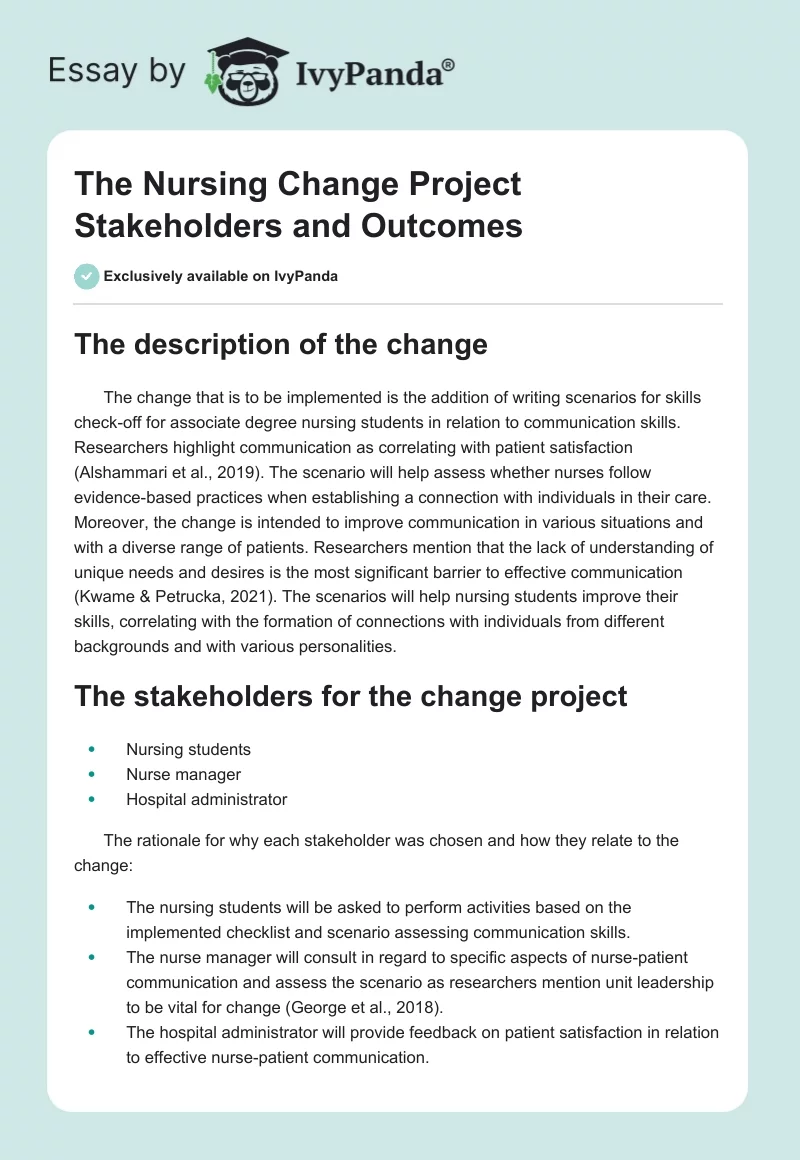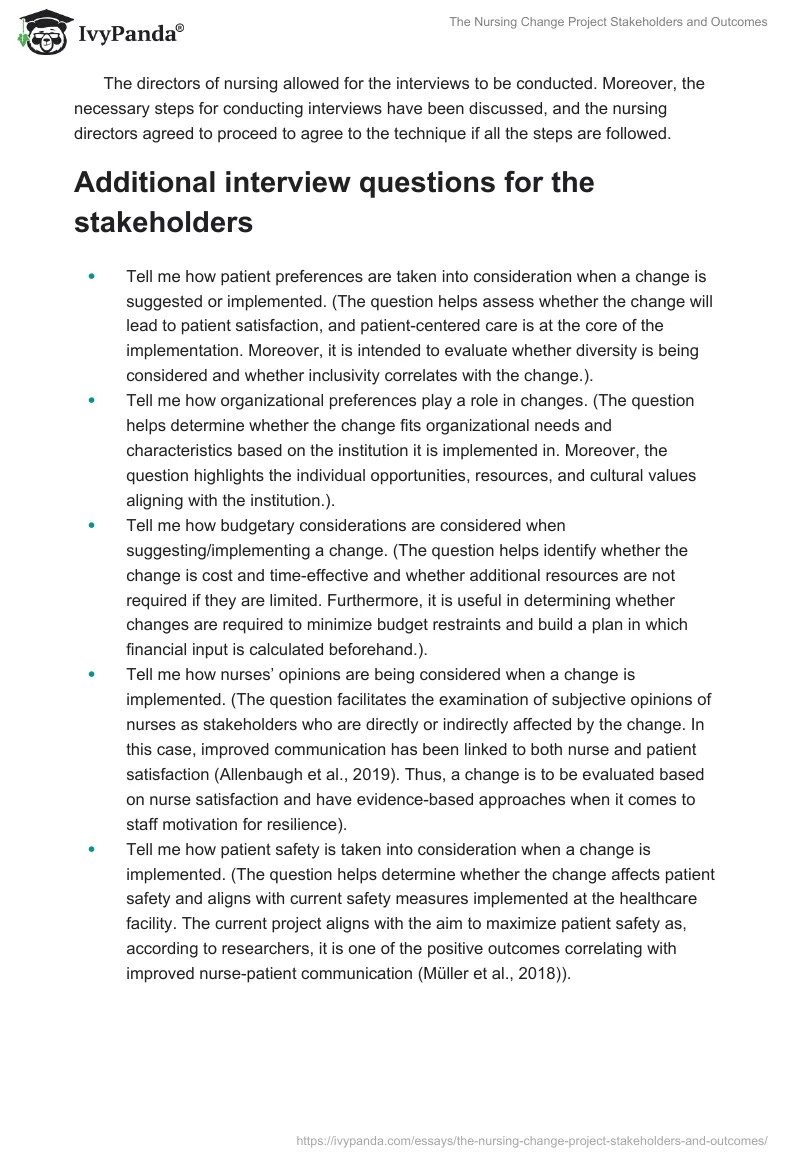The description of the change
The change that is to be implemented is the addition of writing scenarios for skills check-off for associate degree nursing students in relation to communication skills. Researchers highlight communication as correlating with patient satisfaction (Alshammari et al., 2019). The scenario will help assess whether nurses follow evidence-based practices when establishing a connection with individuals in their care. Moreover, the change is intended to improve communication in various situations and with a diverse range of patients. Researchers mention that the lack of understanding of unique needs and desires is the most significant barrier to effective communication (Kwame & Petrucka, 2021). The scenarios will help nursing students improve their skills, correlating with the formation of connections with individuals from different backgrounds and with various personalities.
The stakeholders for the change project
- Nursing students
- Nurse manager
- Hospital administrator
The rationale for why each stakeholder was chosen and how they relate to the change:
- The nursing students will be asked to perform activities based on the implemented checklist and scenario assessing communication skills.
- The nurse manager will consult in regard to specific aspects of nurse-patient communication and assess the scenario as researchers mention unit leadership to be vital for change (George et al., 2018).
- The hospital administrator will provide feedback on patient satisfaction in relation to effective nurse-patient communication.
The directors of nursing allowed for the interviews to be conducted. Moreover, the necessary steps for conducting interviews have been discussed, and the nursing directors agreed to proceed to agree to the technique if all the steps are followed.
Additional interview questions for the stakeholders
- Tell me how patient preferences are taken into consideration when a change is suggested or implemented. (The question helps assess whether the change will lead to patient satisfaction, and patient-centered care is at the core of the implementation. Moreover, it is intended to evaluate whether diversity is being considered and whether inclusivity correlates with the change.).
- Tell me how organizational preferences play a role in changes. (The question helps determine whether the change fits organizational needs and characteristics based on the institution it is implemented in. Moreover, the question highlights the individual opportunities, resources, and cultural values aligning with the institution.).
- Tell me how budgetary considerations are considered when suggesting/implementing a change. (The question helps identify whether the change is cost and time-effective and whether additional resources are not required if they are limited. Furthermore, it is useful in determining whether changes are required to minimize budget restraints and build a plan in which financial input is calculated beforehand.).
- Tell me how nurses’ opinions are being considered when a change is implemented. (The question facilitates the examination of subjective opinions of nurses as stakeholders who are directly or indirectly affected by the change. In this case, improved communication has been linked to both nurse and patient satisfaction (Allenbaugh et al., 2019). Thus, a change is to be evaluated based on nurse satisfaction and have evidence-based approaches when it comes to staff motivation for resilience).
- Tell me how patient safety is taken into consideration when a change is implemented. (The question helps determine whether the change affects patient safety and aligns with current safety measures implemented at the healthcare facility. The current project aligns with the aim to maximize patient safety as, according to researchers, it is one of the positive outcomes correlating with improved nurse-patient communication (Müller et al., 2018)).
The proper procedure for conducting informal interviews
In order for the interviews to be conducted, I am to ask for permission and let the clinical program director and director of nursing know of the intention in written form. After receiving authorization, stakeholders participating in the interviews will consent and be notified of the topic and intentions correlating with the interviews. The aforementioned information was verified by the nursing manager. The participants (interviewees) are to be informed of the confidentiality of the information gathered through the discussions and informed on the purpose of the information gathering.
The specific object outcomes of the project
References
Allenbaugh, J., Corbelli, J., Rack, L., Rubio, D., & Spagnoletti, C. (2019). A brief communication curriculum improves resident and nurse communication skills and patient satisfaction. Journal of General Internal Medicine, 34(7), 1167–1173.
Alshammari, M., Duff, J., & Guilhermino, M. (2019). Barriers to nurse–patient communication in Saudi Arabia: An integrative review. BMC Nursing, 18(1).
George, S., Rahmatinick, S., & Ramos, J. (2018). Commit to sit to improve nurse communication. Critical Care Nurse, 38(2), 83–85.
Kwame, A., & Petrucka, P. M. (2021). A literature-based study of patient-centered care and communication in nurse-patient interactions: Barriers, facilitators, and the way forward. BMC Nursing, 20(1).
Lotfi, M., Zamanzadeh, V., Valizadeh, L., & Khajehgoodari, M. (2019). Assessment of nurse–patient communication and patient satisfaction from nursing care. Nursing Open, 6(3), 1189–1196.
Müller, M., Jürgens, J., Redaèlli, M., Klingberg, K., Hautz, W. E., & Stock, S. (2018). Impact of the communication and patient hand-off tool SBAR on patient safety: A systematic review. BMJ Open, 8(8).


